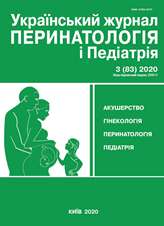Quality of life indicators in pregnant women with a history of different types of infertility
DOI:
https://doi.org/10.15574/PP.2020.83.16Keywords:
short WHO questionnaire, quality of life assessment, pregnancy after infertilityAbstract
Purpose — to study the indicators of quality of life in pregnant women with a history of different types of infertility.
Materials and methods. The study of quality of life indicators was carried out in 127 women aged 20 to 49 years, 97 of whom had a history of infertility of various origins and 30 pregnant women who had it. The distribution of pregnant women into groups was based on the factor of infertility: Group I — 35 pregnant women with a history of endocrine infertility, Group II — 37 pregnant women with a history of inflammatory infertility, Group III — 25 pregnant women with a history of combined infertility of inflammatory genesis with endocrine, Group IV (control) — 30 healthy pregnant women who did not have a history of infertility. The method of assessing quality of life was the WHOQOL-BREF Short Questionnaire.
Results. The indicators of quality of life and general health, according to the subjective assessment of the patients, were the lowest in group III — 2.5±0.10 points and 2.1±0.05 points. In group I patients, the score was 3.1±0.15 points and 3.2±0.20 points and in group II — 3.2±0.10 points and 3.3±0.07 points, respectively. It should be noted that the most positive assessment of these indicators took place in the control group of pregnant women — 5.0±0.3 points. Thus, the physical functioning was assessed by the patients of group III at 16.7±1.1 points, and self+perception — at 20.5±1.6 points. A patient of groups I and II with a history of infertility assessed these indicators — 18.2±1.3 points; 23.4±1.5 points and 19.5±1.4 points; 22.6±1.6 points, respectively. The women in the control group had higher scores — 24.7±1.8 points; 25.7±1.7 points. Microsocial support in groups I, II, III was assessed 8.2±0.3 points; 9.3±0.5 points; 7.7±0.2 points, but in the control group — 13.7±0.1 points. The indicators of social well+being were 22.4±1.8 points; 23.5±1.9 points; 20.6±1.5 in groups I, II, III, and in the control group — 36.4±2.1 points.
Conclusions. In women who became pregnant after long-term treatment of infertility in anamnesis, there was a significant deterioration in quality of life indicators compared with healthy women, which is explained by the high incidence of obstetric complications in them. Determination of quality of life indicators in women with a history of infertility is an integral part of monitoring during pregnancy, which allows adequate assessment and timely correction of physical, social and psycho-emotional functions in the interests of the mother and the fetus.
The research was carried out in accordance with the principles of the Helsinki Declaration. The study protocol was approved by the Local Ethics Committee of these Institutes. The informed consent of the patient was obtained for conducting the studies.
References
Hazova SA, Shipova N.S. (2017). Kachestvo zhizni vzroslyih invalidov s detstva. Vestnik Kostromskogo gosudarstvennogo universiteta. Seriya Pedagogika. Psihologiya. Sotsiokinetika. 3: 96–100.
Karimi M, Brazier J. (2016). Health, Health-Related Quality of Life, and Quality of Life: What is the Difference? Pharmaco Economics. 34 (7): 645–649. https://doi.org/10.1007/s40273-016-0389-9; PMid:26892973
Lebedeva AA. (2012). Teoreticheskie podhodyi i metodologicheskie problemyi izucheniya kachestva zhizni v naukah o cheloveke. Psihologiya. Zhurnal Vyisshey shkolyi ekonomiki. 9 (2): 3–19.
Murphy B, Herrman H, Hawthorne G, Pinzone T, Evert H. (2000). Australian WHOQoL instruments: User's manual and interpretation guide. Australian WHOQoL Field Study Centre. Melbourne, Australia. URL: https://manualzz.com/doc/4197876/australian-whoqol-user-s-manual-and-interpretation-guide.
Novik AA, Ionova TI. (2002). Rukovodstvo po issledovaniyu kachestva zhizni v meditsine. S-Peterburg: 15–40.
Novik AA, Ionova TI. (2004). Issledovanie kachestva zhizni v meditsine. Pod redaktsiey akad RAMN YuL Shevchenko. M: Geotar-Med: 12–13.
Parolin MB, Lazzaretti CT, Lima JH, Freitas AC, Matias JE, Coelho JC. (2004). Donor quality of life after living donor liver transplantation. Transplant Proc. 36 (4): 912–913. https://doi.org/10.1016/j.transproceed.2004.03.098; PMid:15194313
Rasskazova EI. (2012). Metodika otsenki kachestva zhizni i udovletvorennosti: psihometricheskie harakteristiki russkoyazyichnoy versii. Psihologiya. Zhurnal Vyisshey shkolyi ekonomiki. 9 (4): 81–90.
Rasskazova EI. (2012). Metodyi diagnostiki kachestva zhizni v naukah o cheloveke. Vestnik Moskovskogo universiteta. Psihologiya. 14 (3): 95–107.
Ventegodt S, Madsen TF, Andersen NJ, Merrick J. (2008). Which factors determine our quality of life, health and ability? Results from a Danish population sample and the Copenhagen Perinatal Cohort. J Coll Physicians Surg Pak. 18: 445–450.
Ventegodt S, Madsen TF, Anderson NJ, Merrick J. (2005). Factors during pregnancy, delivery and birth affecting global quality of life of the adult child at long-term follow-up. Results from the prospective Copenhagen Perinatal Birth Cohort 1959–1. Scientific World J. 5: 933–941. https://doi.org/10.1100/tsw.2005.112; PMid:16327937 PMCid:PMC5936498
Vsemirnaya organizatsiya zdravoohraneniya. (2018). Oprosnik kachestva zhizni Vsemirnoy organizatsii zdravoohraneniya (yadernyiy modul). URL: http://psylab.info.
Downloads
Published
Issue
Section
License
The policy of the Journal “Ukrainian Journal of Perinatology and Pediatrics” is compatible with the vast majority of funders' of open access and self-archiving policies. The journal provides immediate open access route being convinced that everyone – not only scientists - can benefit from research results, and publishes articles exclusively under open access distribution, with a Creative Commons Attribution-Noncommercial 4.0 international license(СС BY-NC).
Authors transfer the copyright to the Journal “MODERN PEDIATRICS. UKRAINE” when the manuscript is accepted for publication. Authors declare that this manuscript has not been published nor is under simultaneous consideration for publication elsewhere. After publication, the articles become freely available on-line to the public.
Readers have the right to use, distribute, and reproduce articles in any medium, provided the articles and the journal are properly cited.
The use of published materials for commercial purposes is strongly prohibited.

